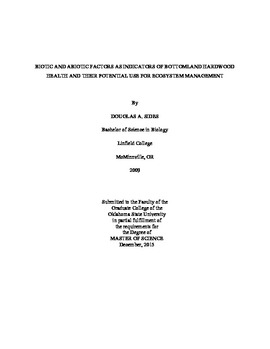| dc.contributor.advisor | Hallgren, Steve | |
| dc.contributor.author | Sides, Douglas Andrew | |
| dc.date.accessioned | 2017-02-22T22:13:08Z | |
| dc.date.available | 2017-02-22T22:13:08Z | |
| dc.date.issued | 2015-12-01 | |
| dc.identifier.uri | https://hdl.handle.net/11244/49013 | |
| dc.description.abstract | My research focused on investigating anecdotal reports from the U.S. Fish and Wildlife Service of decline in the bottomland hardwoods of the Deep Fork National Wildlife Refuge (DFNWR) outside of Okmulgee, OK. The overall goals of the project were to determine 1) extent and severity of forest decline in the DFNWR and 2) whether decline could be attributed to environmental variables. Data included observations from the vegetation and the soils. Vegetation observations aimed to gather information on species richness, density, health, and size distribution of overstory, midstory, and understory vegetation; soil observations included recording soil texture, color, and the presence or absence of redoximorphic features which aimed to give insight to the water holding and infiltration capacity, as well as relative moisture in the soils of the Deep Fork. The most important finding of this study was there was no evidence of forest decline in the DFNWR bottomland hardwoods. Mortality was limited in the overstory and the principal species included pin oak (Quercus palustris), pecan (Carya illinoensis), green ash (Fraxinus pennsylvanica), American elm (Ulmus americana), and sugarberry (Celtis laevigata). Soil observations demonstrated the prominence of silty clay soils and that overall the bottomland soils drain slowly. Soil redoximorphic features generally indicated that the soils were moderately inundated for prolonged periods of time. In addition Canonical Correspondence Analysis (CCA) indicated that of all environmental variables, soil texture had the most important effect on species composition in the Deep Fork bottomland hardwoods. | |
| dc.format | application/pdf | |
| dc.language | en_US | |
| dc.rights | Copyright is held by the author who has granted the Oklahoma State University Library the non-exclusive right to share this material in its institutional repository. Contact Digital Library Services at lib-dls@okstate.edu or 405-744-9161 for the permission policy on the use, reproduction or distribution of this material. | |
| dc.title | Biotic and Abiotic Factors as Indicators of Bottomland Hardwood Health and Their Potential Use for Ecosystem Management | |
| dc.contributor.committeeMember | Zou, Chris | |
| dc.contributor.committeeMember | Carter, Brian | |
| osu.filename | Sides_okstate_0664M_14358.pdf | |
| osu.accesstype | Open Access | |
| dc.description.department | Natural Resources and Ecology Management | |
| dc.type.genre | Thesis | |
| dc.type.material | text | |
